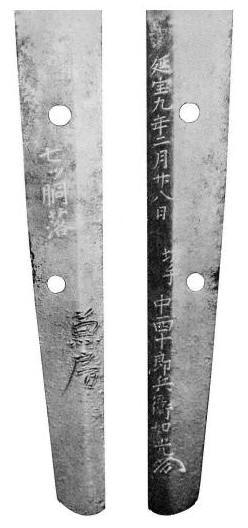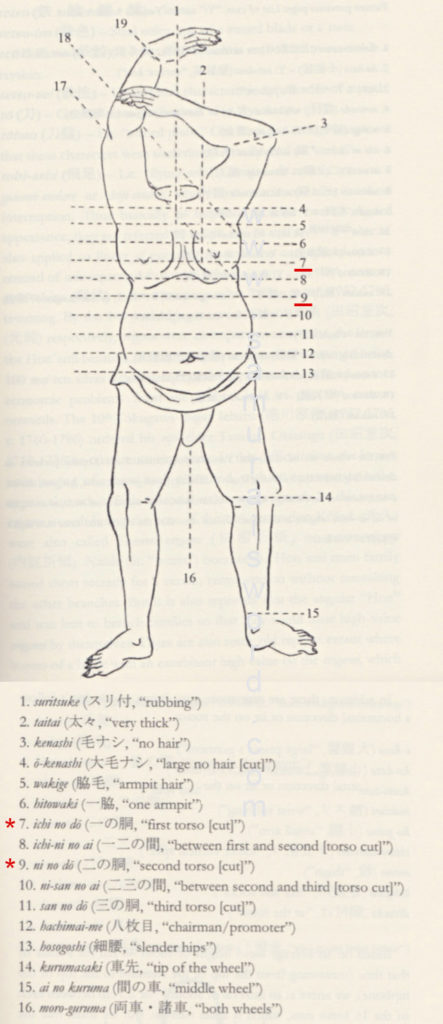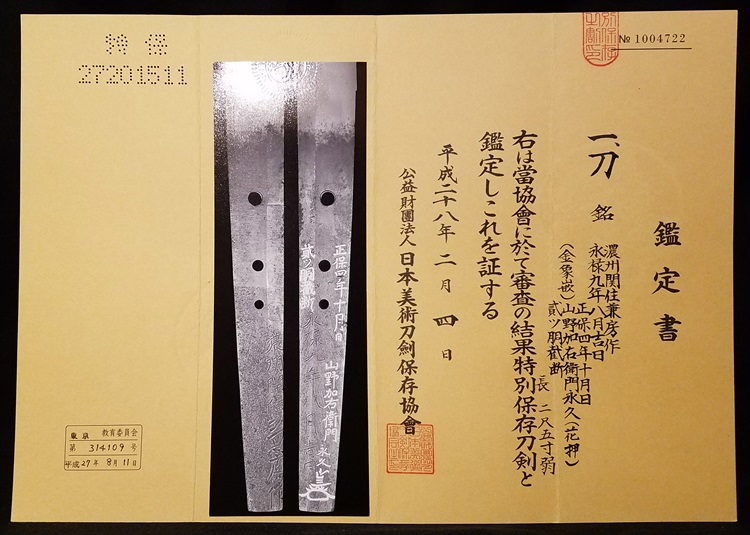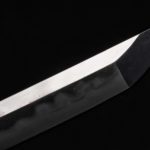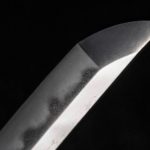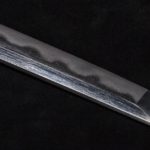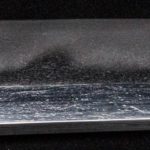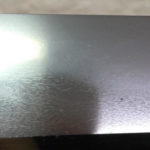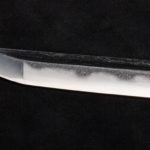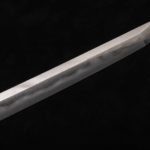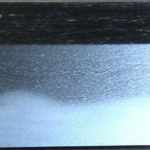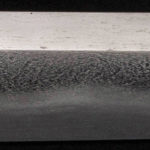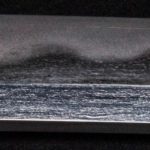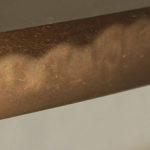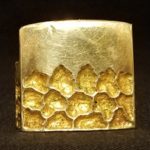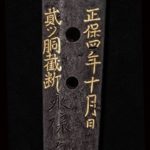Gallery Page (Display Only)
Description
A Koto Kanefusa KATANA, dated August 1566 AD.
W/ 2 Body cutting test
Sayagaki by Tanobe Michihiro (TANZAN)
NBTHK Tokubetsu Hozon Certificate
Swordsmith: Noshu Seki-ju Kanefusa
Location: Seki
Nagasa (cutting edge length): 75.7 cm Sori (curvature): ~ cm Motohaba (width): ~ cm
Hada: Mokume, deki
Hamon: Seki-typical undulating (midare) with Kenbo-midare mixed in.
Nakago: suriage, 3 mekugiana
Signature: Noshu Seki-ju Kanefusa saku, Dated- Ei-Roku 9th year, 8th month , a lucky day (1566, Aug)
Cutting test: A day in the tenth month Shoho four (1647), Yamano Ka’emon Nagahisa + kao, Cut through two bodies
Certificate: NBTHK Tokubetsu Hozon (a sword Extraordinarily Worthy of Conservation by the Society for the Preservation of the Japan Art Sword)
Sayagaki:
By Tanobe Michihiro (TANZAN). Translation: The blade is suriage but preserves its seven character signature and its date of Eiroku nine (1566) and bears in addition the gold inlayed result of a cutting test by Yamano Ka’emon Nagahisa cutting in Shoho four (1647) through two bodies. The bade is long, has a powerful shape, and shows a Seki-typical undulating hamon that is mixed with the peculiar hamon of that smith, which is a Kenbo-midare. The hardening is rich in variety and the deki is excellent.
Blade length ~ 75.7 cm
Written by Tanzan Hendo (Tanobe Michihiro) in March of the year of the horse of this era (2014) + kao
Ratings:
Fujishiro’s reference: Chu Jo Saku (Above average made) is rated chu-jo saku
Sharpness rating: Kokan Kaji Biko by Yamada Asaemon- rated as Wazamono.
Included: Shirasaya, carry bags
A very fine Koto period 76 cm (cutting edge) with rare 2 body gold inlay (kinzogan) cutting test. It is rare to have a cutting test blade where the smith inscribed the date of which the sword was made. Furthermore, we generally do not see cutting test on Koto blades. With NBTHK Tokubetsu Hozon papers. It is also very interesting to note that the omote tang side at one point in time had additional kinzogan (gold inlay) that was partially removed and or covered with lacquer, now covered with aged patina (see images). There are specs of kinzogan that are now showing through, this area has a step in the tang where the area was filed down. The sayagaki is by Tanobe Michihiro (TANZAN). Kanefusa made the sword in August of 1566, the cutting test was done in 1647. Kanefusa has one known katana of his which bears cutting the Nagahisa’s earliest known testing was in 1639 so this is an relatively early example. In an initiation script by Nagehisa it is read that he “performed tameshigiri virtually every day, and that he used up to five or seven, sometimes even 27 bodies, a day. He also states that he was sixteen years old at his first tameshigiri on a human being and that between the age of twenty and fifty alone he tested swords on over 6,000 bodies.”
Excerpts
Quoted text & image to the left regarding Nagahisa are from the book “Tameshigiri – The History and Development of Japanese Sword Testing” By Markus Sesko pages 50, 51 & 191. Available for purchase – click here.
“The earliest extant tameshi-mei of Nagahisa is from the 13th day of the eighth month of Kan’ei 15 (1639), found on a blade by the Seki smith Kanefusa (兼房), and the last is from Kanbun seven (1667), the year he died. So we can calculate an active period of around 40 years. In his initiation script we read that he performed tameshigiri virtually every day, and that he used up to five or seven, sometimes even 27 bodies, a day. He also states that he was sixteen years old at his first tameshigiri on a human being and that between the age of twenty and fifty alone he tested swords on over 6,000 bodies. But he still lived for twenty more years and so the figure must be revised upwards to probably around 10,000! This figure also speaks for the large number of death sentences given during the early Edo period. We learned that officially only two death sentences, shizai and gokumon, provided the sword testers with mediums. And the figure of around 10,000 is for Nagahisa alone.
Nagahisa further writes in his initiation script that due to his extensive experience he is able to judge the cutting ability, smith, and age of the smith simply from looking at a blade when preparing it for the cut, and just by listening to the sound of a blade when another person performs a cutting test. We also learn from his hiden-sho, handed down to certain of his students in Shōhō two (1645), that he considered his techniques at the rather early age of 47 as being perfect enough to pass on.”
It’s important to note: “The highest number of cut-through bodies is seven, nanatsu-dō (七ッ胴). Suishinshi Masahide writes in his Tōken-bengi that he heard of the existence of a blade by Bizen Motomitsu (基光) cutting through seven bodies, but the only one extant today is probably the famous katana of Kanefusa (兼房) shown below. The kinzōgan-tameshi-mei reads: “Nanatsu-dōotoshi” (七ッ胴落) and “Enpōkyūnn nigatsu nijūhachinichi – kirite Nakanishi Jurōbei Yukimitsu + kaō” (延宝九年二月廿八日・切手中西十郎兵衛 如光, “tested by Nakanishi Jurōbei Yukimitsu on the 28th day of the second month of Enpōnine [1681] by cutting through seven bodies”).”
Sayagaki
translation:
濃刕関住兼房
磨上而七字銘與永禄九年紀並ビニ正保四年山野加右衛門永久弐ッ胴截断ノ象嵌有之 長寸雄勁ナ姿態ニ同工得意ノ兼房乱ヲ交ヘル起伏アル関氣質ノ刃文ヲ焼キ変化ニ富ミ出来宜矣 長弐尺四寸九分余
惟時甲午五陽 探山邉道識
Noshu Seki-ju Kanefusa
Suriage shikaru ni shichiji-mei yo Eiroku kyu nenki narabi ni Shoho yonen Yamano Ka’emon Nagahisa futatsu-do setsudan no kinzogan kore ari. Chosun yukei na shitai ni doko tokui no Kenbo-midare o majieru kifuku aru Seki kishitsu no hamon o yaki henka ni tomi deki yoroshii.
Nagasa 2 shaku 4 sun 9 bu yo Koretoki kinoe-uma goyo Tanzan Hendo shirusu + kao
Noshu Seki-ju Kanefusa
The blade is suriage but preserves its seven character signature and its date of Eiroku nine (1566) and bears in addition the gold inlayed result of a cutting test by Yamano Ka’emon Nagahisa cutting in Shoho four (1647) through two bodies. The bade is long, has a powerful shape, and shows a Seki-typical undulating hamon that is mixed with the peculiar hamon of that smith, which is a Kenbo-midare. The hardening is rich in variety and the deki is excellent.
Blade length ~ 75.7 cm
Written by Tanzan Hendo (Tanobe Michihiro) in March of the year of the horse of this era (2014) + kao
NBTHK Tokubetsu Hozon translation
kantei-sho (鑑定書) No 1004722
katana, mei: Noshu Seki-ju Kanefusa saku (農州関住兼房作)
Eiroku kyunen hachigatsu kichijitsu (永禄九年八月吉日)
kinzogan: Shoho yonen jugatsu hi (正保四年十月日)
Yamano Ka’emon Nagahisa + kao (山野加右衛門永久) Futatsu-do saidan (貳ッ胴截断)
nagasa 2 shaku 5 sun jaku
Migi wa to-kyokai ni oite shinsa no kekka, tokubetsu-hozon-token to kantei-shi kore o sho-suru. (右は當協會に於て審査の結果特別保存刀剣と鑑定しこれを証する)
Heisei nijuhachinen nigatsu yokka (平成二十八年二月四日)
koeki-zaidan-hojin (公益財團法人): Nihon Bijutsu Token Hozon Kyokai (日本美術刀劍保存協會)
Appraisal
katana, signed: Noshu Seki-ju Kanefusa saku
A lucky day of the eighth month Eiroku nine (1566)
kinzogan: A day in the tenth month Shoho four (1647) Yamano Ka’emon Nagahisa + kao
Cut through two bodies
nagasa ~ 75.7 cm
According to the result of the shinsa committee of our society we judged this work as authentic and designate it as tokubetsu-hozon-token.
February 4th 2016
[Foundation] NBTHK
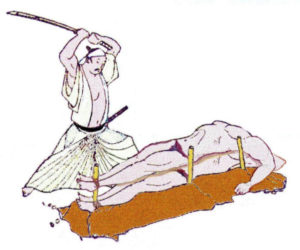
This is the most common region cut for multiple body cutting tests.
This shows example how two bodies were stacked before the cutting test

And the above image depicts the result
Gallery
Following are details translated from the Fujishiro reference book:
UJIFUSA – KANEFUSA(5) EI-ROKU 1558: KYOSABURO. 3rd from ZENSEI KANEFUSA. Had to straighten affairs and bring IWAMI-no-KAMI KANEFUSA back from OWARI (KO-JI NINEN, 1556). The SORYO SHIKI sword production house was thereby unbroken. KANEFUSA(5) received WAKASA-no-KAMI title in EI-ROKU JUSAN 1570 and changed his name to UJIFUSA. In TENMON SANNEN 1534, he had moved from GIFU to SEKI. EIROKU JUNEN, he moves back to take control of sword-making at GIFU Castle. In EIROKU JUSAN 1570, he becomes SHOI second in responsibilities for sword-making and family affairs. The same year he received his title. TENSHO GONEN 1577, his arrives at AZUCHI. Following the death of ODA NOBUNAGA, UJIFUSA moves to KIYOSU, OWARI. UJIFUSA dies in TENSHO JUHACHI 1590, 57 years of age. He makes KANEFUSA JIDAI tight NIOI-GUCHI GUNOME-MIDARE BA with TOBI-YAKI of the late style. UJIFUSA converts to a SHINTO-like style with his second son, whose new world MOMOYAMA order was in ascendency. -Wide MIHABA with O-KISSAKI of particular grandeur. ITAME HADA with thin JI-NIE. Extravagant GUNOME O-MIDARE CHOJI-MIDARE with TOBI-YAKI. O-NOTARE of GUNOME-MIDARE with TOBI-YAKI and SUNGASHI. See SHINTO OWARI His earlier WAKASA-NO-KAMI MEI will be smaller, where his UJIFUSA are large.
*Examples of known signatures:
UJIFUSA
KANEFUSA
UJIFUSA NYUDO
KANEFUSA TSUKURU
FUJIWARA UJIFUSA SAKU
WAKASA-no-KAMI UJIFUSA
NOSHU SEKI JU KANEFUSA SAKU
SEKI JU FUJIWARA UJIFUSA
SAEMON-no-JO FUJIWARA UJIFUSA
WAKASA-no-KAMI UJIFUSA TSUKURU
WAKASA-no-KAMI FUJIWARA UJIFUSA SAKU
This Sword is not available for purchase.
If you wish to purchase a Japanese Sword please view our Nihonto for sale page or contact us directly via email or contact us at 1(608) 315-0083 any time, please include specifics of what you seek, i.e.: Katana, maker, era, price range etc.
Pictures and content may not be copied without the express permission of samuraisword.com ©



